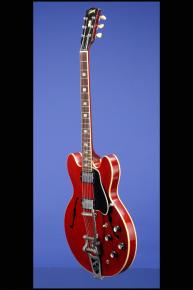One of the Last of the "Great" 335s
With Factory Ordered Bigsby
This 16-inch-wide semi-hollow body guitar, with a solid maple block running lengthwise down the center, weighs just 8.10 lbs. and has a nice, meaty nut width of 1 11/16 inches and a standard Gibson scale length of 24 3/4 inches. Laminated maple body with single binding on the top and back edges, one-piece mahogany neck with a typical wonderful medium-to-thick '64 profile, and bound Brazilian rosewood fretboard with 22 jumbo frets and inlaid pearl block position markers. Headstock with inlaid pearl "Gibson" logo and pearl crown inlay. Two-layer (black on white) plastic truss-rod cover. Serial number ("177383") impressed into the back of the headstock. Individual dual-line Kluson Deluxe tuners with double-ring Keystone plastic buttons and "D-169400 / PATENT NO." stamped on the underside. Oval orange label inside the bass f-hole with the (incorrect) style ("ES-345TDC") and serial number ("177383") written in black ink. Two very hot "patent-number" humbucker pickups with outputs of 8.11k and 7.94k. Each pickup with a black label ("Patent No. 2,737,842") on the underside. Five-layer (black/white/black/white/black) plastic pickguard with bevelled edge. Four controls (two volume, two tone) plus three-way pickup selector switch, all on lower treble bout. Black plastic bell-shaped knobs with white markings and metal tops. ABR-1 Tune-O-Matic retainer bridge with nylon saddles and specially ordered factory Bigsby tailpiece. At one time this guitar was fitted with Grover single-screw tuners, but these have long ago been removed and the original Kluson Deluxe tuners re-fitted to the guitar. The only evidence of this is the slightly larger shaft holes which can only be seen when the tuners are removed. There is a small 'ding' to the upper binding on the bass side of the body near the tailpiece, otherwise this spectacular guitar is in near mint condition but because of the tuner issue we will give it a conservative (9.00) 'exceptionally fine' rating, Housed in its original Gibson black hardshell case with four latches and orange plush lining (8.75).
This a "transitional" example, and being a late 1964, is one of the first guitars to be made without the traditional stud holes for the stop-tailpiece, but instead of being fitted with a "trapeze" tailpiece, this specially custom-ordered guitar was factory fitted with a Bigsby tailpiece while still retaining the preferred "fat" nut width of 1 11/16 inches. In early to mid 1965 the nut width was decreased to 1 9/16 inches (known as the small neck), and then in 1966 the specifications were radically changed: the peghead angle was changed from 17 degrees to 14 degrees and Indian rosewood replaced the Brazilian rosewood on the fretboard. Although a total of 1,038 ES-335TDCs were produced in 1965, the number of "earlier" examples such as this one, with the 1964-style neck, is infinitely smaller. This is truly the one of the last of the great ES-335s which dominated the thinline electric guitar market from the spring of 1958 to the beginning of 1965!
One tiny anomaly is that the model designation on the orange label has "ES-345 TDC" written in ink instead of "ES-335 TDC -- I guess the guy that filled in the labels had a very late night!
"Introduced in 1958, the ES-335T (originally no final D) truly ranks among the all-time Gibson classics, not only because of its enduring popularity but also because of its semi-solid construction which pioneered a new style of electrics" (A.R. Duchossoir, Gibson Electrics -- The Classic Years, p. 231).
"There were indeed a number of firsts in the early days of the electric guitar, but in retrospect only few of them can be considered as true milestones. The double cutaway thinlines pioneered by Gibson in 1958 genuinely rank amongst the great original designs. Their graceful shape was truly innovative at the time and spawned several imitations such as Gretsch's revamped Chet Atkins series or the Guild Starfire. But perhaps the most important hallmark of the new thinline was their semi-solid construction. Indeed Gibson's prime objective was to design an instrument that would combine the advantages of both solid and hollow body electrics and therefore appeal to a variety of players, regardless of their musical style" (A.R. Duchossoir, Gibson Electrics -- The Classic Years, p. 77).
Translate:









